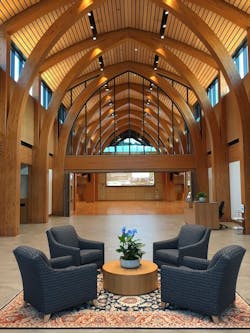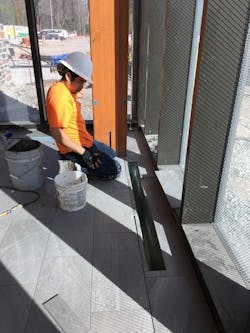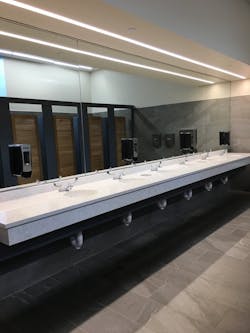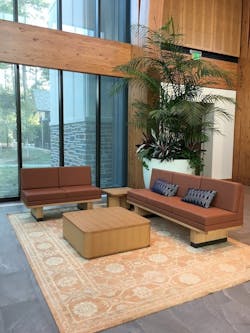Professional interviews, first dates, meeting the in-laws. Anyone will tell you in these situations that first impressions are critical. The same can be said for when you first enter the campus of a university. With the goal in mind to create an inviting environment for the students, returning alumni, visitors and the community-at-large, a new alumni and visitors center was proposed. Designed to offer a gateway to bolster alumni relations with new meeting and social spaces, it would provide the space and opportunities to unify the alumni association while providing a warm welcome to campus guests. Located near the Forlines House and at the main entry to Duke University’s renowned Gothic Revival West Campus, the Karsh Alumni and Visitors Center is surrounded by woods, which perfectly embodies the university commonly known as the "University in the Forest."
Centerbrook Architects & Planners was tapped to lead the design of the new Karsh Alumni and Visitors Center, with Mark Simon, FAIA, as the lead architect. The project totaled nearly 48,000 square feet (4459 m2) of new construction and renovations with complexity including a historic renovation, an office building, a flexible event space designed to facilitate indoor and outdoor events and extensive site development. Tile Setters of Raleigh were chosen as the tile contractors with the objective to install an expansive area of large format porcelain tile in the main lobby and on the floors and walls in the bathrooms. The same large format porcelain tile was also used for the lobby floor and restrooms in the office building.
“We used LATICRETE throughout the interiors wherever we had tile. We were required to maintain an open specification, but LATICRETE remains a top choice in our specifications as a proven option for tile grout,” said Alan Paradis, Senior Associate, Centerbrook Architects & Planners.
The Challenges:
- Flooring layout: Designed to provide multiple uses for the university, the complexity of the project required simultaneous new construction and renovation work. As such, substrates and installation methods varied. The footprint of the events building was recessed, requiring special care where tile floor met wood flooring and entries. Further, the tile flooring employed a continuous pattern that ran through several corridors, a café, a main lobby and gang restrooms – so the entire layout had to be considered to ensure there were no unsightly cut pieces.
- Aesthetics and durability: The tile finishes throughout the project were very prominent and meant the overall appearance of the products was paramount. Durability was also absolutely critical, as the university expected a lasting and beautiful outcome that would serve the community for years to come. With the extent of the tile finishes, any failure would be costly and disruptive.
- Compacted schedules: The project dealt with a compacted schedule due to climate conditions and multiple trades working simultaneously in the same space. With tile throughout the lobby, corridors and bathrooms needing time to cure properly, a high level of coordination of manpower combined with effective, user-friendly products was critical. Getting sufficient heat to bond during colder weather was also a challenge with cold temperatures slowing down curing time.
A LATICRETE Solution:
Since Tile Setters of Raleigh would be applying tile to a variety of substrates, versatility of the adhesive was essential. Due to constricted schedules and multiple trades working simultaneously in the same area, it was also required to have products that were user-friendly and easy-to-mix. Above all, the overall appearance and quality of the installation had to meet exceptional standards to ensure an end-result that Duke University would be able to utilize for many years.
“The products that LATICRETE offer provide a high profile of quality and durability that we and our client could be proud of,” said Eric Lupo, President of Tile Setters of Raleigh. “The goal was also to meet standards equivalent to LEED Silver certification and we needed products that would help us reach and exceed those requirements.”
For tile adhesive, LATICRETE® 253 Gold was selected. A superior polymer fortified bagged cementitious thin-set powder, 253 Gold is mixed with water to install using the thin bed method of installation. Designed for interior and exterior floor and wall installations of all types of ceramic tile, porcelain tile and stone, it bonds to most surfaces including over concrete, exterior glue plywood and a variety of other substrates. 253 Gold exceeds ANSI A118.4, A118.11 and ISO 13007-1 standards.
To provide a grout solution that is aesthetically pleasing and provides durability, PERMACOLOR® Grout was installed for all tile. PERMACOLOR Grout is a high-performance, fast-setting grout that provides a grout joint that is dense and hard. Providing superior color-consistency without blotchiness and resisting efflorescence, it is also easy to install and requires only water to mix. The cement-based formula is fiber-reinforced to provide superior strength while resisting cracking and powdering. Finally, it is also equipped with Microban® antimicrobial protection.
For the restrooms, waterproofing was especially necessary to ensure a durable and lasting installation. HYDRO BAN®, a thin, liquid-applied, waterproofing and anti-fracture membrane was employed for its rapid drying formula designed to save construction professionals time and money on the jobsite. HYDRO BAN provided the installers a faster time to tile, which allowed the entire installation to be completed quicker. While other waterproofing membranes on the market can take up to a week to cure before allowing for flood tests, HYDRO BAN can be tested in as little as two hours. Moisture issues related to failed floor tests are not a concern thanks to this product’s reliability.
“We chose LATICRETE products because we are familiar with their proven user-friendly effectiveness on the job site. With construction schedules being tighter and tighter these days, we needed a quick turnaround and efficient usability without compromising on quality and craft,” said Lupo.
Outcome:
The Karsh Alumni and Visitors Center was crafted to harbor a distinct character while also providing for a host of stakeholders including the alumni association, students, staff, visitors and serving as a public building. While the project was designed to meet Duke University's sustainability initiatives overall (equivalent to LEED silver), the project was not LEED-certified. Because the overall complexity of the project required extensive site development, Centerbrook Architects & Planners felt it was not conducive to conform to the typical checkbox administration in achieving their sustainability goals.
“What was more important to the design team and our client was the quality of the materials and craftsmanship. Toward this end, it is my belief that the contractor’s confidence with the material and willingness to back their work is even more critical than the material warranty,” said Alan Paradis, Senior Associate, Centerbrook Architects & Planners.
“I’m very much pleased with the outcome of The Karsh Alumni and Visitors Center and believe the community-at-large is pleased as well,” said Sally Curtis, Project Manager for the Duke Facilities Management Department at Duke University. “As a highly visible first arrival point and the first impression at the gate of the university, the Karsh Alumni and Visitors Center is an enduring and beautiful building the university and community can champion around and we appreciate everyone that made the project what it is.”
Photo Credit: Duke University




